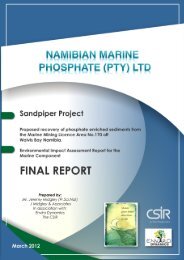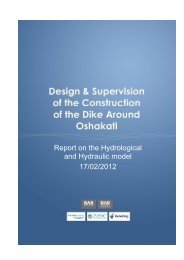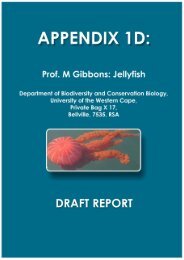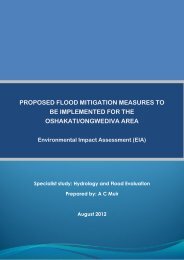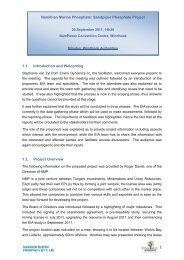Fisheries - Enviro Dynamics Namibia
Fisheries - Enviro Dynamics Namibia
Fisheries - Enviro Dynamics Namibia
You also want an ePaper? Increase the reach of your titles
YUMPU automatically turns print PDFs into web optimized ePapers that Google loves.
F I S H E R I E S , M A M M A L S A N D S E A B I R D S S P E C I A L I S T S T U D Y<br />
numerous mammal and bird species will be occasionally found in or near the MLA (Para. 4.3<br />
refers). Most mammal species are naturally inquisitive and certainly, any dredging activity will<br />
attract small marine mammals e.g. dolphins and seals. Larger, mostly migrating mammals are<br />
expected to avoid areas where maritime activity is high (although this does not exclude the<br />
possibility that large mammals will occasional be found in or near the MLA).<br />
Impacts on birds and marine mammals will nevertheless be limited to the actual mining site and<br />
immediate areas (500 m around the dredging location). Disturbance of the substrate is also likely<br />
to result in higher levels of biological activity, increased particulate matter (assumed of poor<br />
nutritional value) in the water column and at the surface. This will alter bird behaviour as they will<br />
be naturally attracted to these areas. The significance of the impact is summarised in Table 8.<br />
Table 8. Table of assessment of Impact 5 summarizing the likely impact of phosphate mining on the<br />
seabirds and mammals around the MLA.<br />
Nature of the<br />
impact<br />
Extent<br />
Duration<br />
Intensity<br />
Probability<br />
Status (+ or -) Negative<br />
Significance (no<br />
mitigation)<br />
Mitigation<br />
Significance (with<br />
mitigation)<br />
Confidence level<br />
Final Report<br />
<strong>Namibia</strong>n Marine Phosphate (Pty) Ltd.<br />
The impact of phosphate mining on seabirds and marine mammals. Mining operations<br />
might result in the displacement and/or redistribution of seabirds and mammals<br />
because of 1) disturbance of the ecosystem and availability of feed and 2) physical<br />
disturbance of the dredgers including noise pollution<br />
MLA - impact on seabirds and mammals is restricted to areas inside the mining licence<br />
area (ML 170) and possibly the surrounding areas including Zone 1<br />
Medium term – The impact on sea birds and mammals will be for the term of the<br />
exploitation. Occasional interaction between the dredging operations and mammals and<br />
seabirds is likely although the actual level cannot be determined without more specific<br />
information on these groups for the MLA and Zone 1. Once mining ceases these groups<br />
will no longer be affected by the presence of the dredger although the alteration of<br />
behaviour of some species due to possible loss of foraging options cannot be<br />
determined.<br />
Minor effects - Trophic disturbances could have an impact on the behaviour of seabirds<br />
and marine mammals. Noise pollution is a consideration for marine mammals whose<br />
acoustic communications may be affected resulting in avoidance of the area. Night<br />
strikes of birds due to deck lights are likely.<br />
Probable - consequences of trophic interaction disturbances and noise pollution is highly<br />
likely.<br />
Medium – Most sea birds and mammal species found in the area will be affected but at a<br />
low level due to the limited extent of the mining operations.<br />
Maintain a bridge watch for large mammal species. Although the dredger will have<br />
limited manoeuvrability a protocol to limit interaction should be followed – in this regard<br />
JNCC guidelines are recommended. Lighting control to minimise night strikes of birds.<br />
Low<br />
Medium - information based on seabirds and mammals was provided by scientific<br />
specialists, however spatial data is limited. Baseline applies to the whole <strong>Namibia</strong>n coast<br />
for most bird and mammal species – confidence relating to impact in the actual MLA is<br />
therefore low.<br />
Page 74



